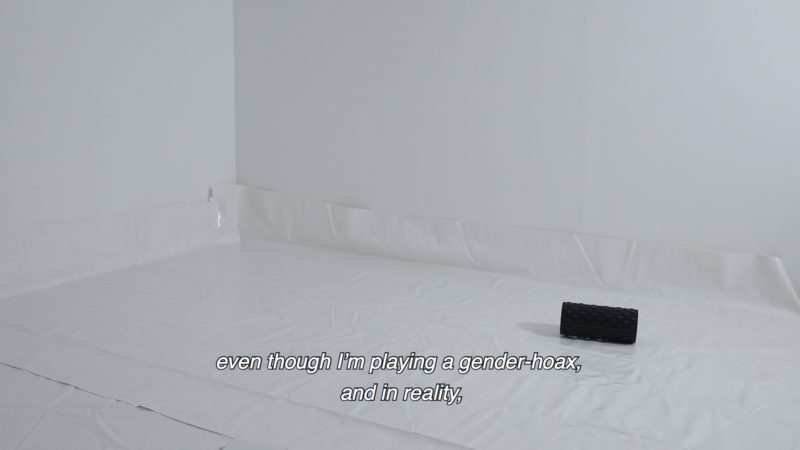10 Dec 2020
Interview
ELIS HANNIKAINEN: THE TRANSIENT COMFORT OF TIREDNESS AND ENDORPHINS
Berlin and Helsinki based artist Elis Hannikainen was a HIAP resident artist between September and November 2020. Together with artist and writer Vappu Jalonen, they have been working on Distress Run, a project based on their experience of endurance sports. Distress Run will be shown at HAM Gallery in Helsinki in 2021. They have worked on the project since 2019.
Elis is currently making work that combines text-based video with sculptural installations.
During their time at HIAP, Elis enjoyed the normality of life: amidst a global pandemic, life on the island of Suomenlinna was peaceful yet social, with the residents making time to share ideas and meet up regularly. Elis also enjoyed being able to meet with Vappu regularly to work on their project; now Elis is back in Berlin, and the work process takes place mostly online.

Elis Hannikainen and Vappu Jalonen, Distress Run, HIAP Open Studios (video still), 2020.
AA: You have been working on a collaborative project with Vappu Jalonen, Distress Run, that deals with endurance sports and the blurred boundaries between ability and inability. Running is, of course, something that those suffering from mental illnesses are often advised to do; yet, anxiety can feed and grow on expectations of performance. What makes us feel that kind of urgency? What are we running away from and towards?
EH: Going for walks before going to bed or starting running regularly is the advice many probably get when facing any mental health hardship. It can help, but can also be difficult, complex or just completely unrewarding.
Running, or other regular exercise that has to do with endurance, is linked to notions of ability, sisu and even some kind of upright citizenship. That it is more controllable and measurable than most things is what makes regular exercise appealing. In Distress Run we attempt to talk about something that would rub against to those connections. In Distress Run, exercise is about dealing with anxiety and one’s gender, about failure and always losing to others, about some awkward fantasies and about the transient comfort of tiredness and endorphins.
AA: People who are not allowed or don’t have the opportunity to participate in public demonstrations, may feel powerless in so many ways in their lives; a subject you addressed in Desirable Movement. What happens to a person if they are, indeed, unable to participate? If they are not able to keep pushing themselves to go further and faster?
EH: Desirable Movement as an installation consisted of fragmentary text snippets, Noha Ramadan’s and Zoë Knights’ dance improvisation in a video, literary quotes and tape on floor. It was about the way protest can present itself in private spaces, in resting bodies, in small gestures and short words.
Something that interests me is the figure of a resting body and the figure has seemed to travel from work to work. The interest has at the same time shifted to the materials that support and carry that body.

Elis Hannikainen, This Isn’t Consoling, HIAP Open Studios (photography by Sheung Yiu @sheungyiuphoto), 2020.
AA: In This Isn’t Consoling the body is, once again, in need of sheltering. The body in question is not consoled, but also not pushed towards achievement. Is this work kinder than Distress Run?
EH: This Isn’t Consoling is a sound piece and a text video, and it describes the body as something that is leaky and coming apart and in need of elastic and adhesive materials to support it. The way the body is talked about here is not exactly kind. The relationship of the body and the materials is one of dependence, and that brings both comfort and frustration with it.
AA: You have also touched upon ideas of remembering and performances of personal narrative. Are our memories constructed to fit a story we wish to tell?
EH: I’ve been interested in displays of personal narrative that complicate things like accountability and authorship, in mixing texts with each other and in someone performing someone else’s memories. These kind of constructions can also help to maintain the personal opacity that is anyone’s right.
AA: You often work with other artists, sometimes also taking on the role of the curator. How has the collaborative process influenced your work?
EH: What has mattered a lot in the common working process is the endless exchange. Whatever I come up with during the process, I can ask for the other’s view on it. I’m maybe spending less time hesitating because of this.
Writing is difficult, but in Distress Run, I have Vappu as an audience, someone to write for. We are both bringing to Distress Run subjects that we’ve been dealing with before, and hopefully the whole thing will form some kind of dialogue.
Also, when you face the uncertainty of the working conditions together, it takes away some of the emotional trouble that often is there.

Elis Hannikainen and Vappu Jalonen, Distress Run (video still, videography by Camille Auer), 2019.
Photos provided by the artist.
Elis Hannikainen’s residency was realised with support from the Nordic Culture Point.
Read more:
